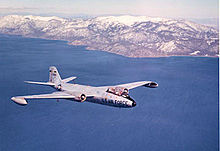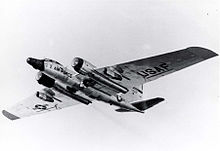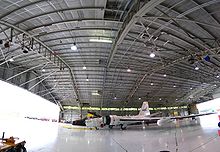- Martin RB-57F Canberra
-
Martin RB-57F Canberra Martin/General Dynamics RB-57F-CF in flight Role Reconnaissance Manufacturer Martin; Re-manufactured by General Dynamics First flight 23 June 1963 Introduction 1963 Status Retired (2 still used by NASA[1]) Primary users United States Air Force
Pakistan Air Force
Republic of China Air Force
National Aeronautics and Space AdministrationNumber built 21 Developed from English Electric Canberra The Martin RB-57F Canberra was a highly specialized strategic reconnaissance aircraft developed by General Dynamics in the 1960s from the B-57 Canberra tactical bomber. It was later used by the Air Weather Service for weather reconnaissance (WB-57F), and later by NASA for high-altitude atmospheric research.
WB-57Fs are the only B-57 aircraft model still flyable and in service (NASA, 2011).
Contents
Development
In 1962 General Dynamics Corporation had a contract the United States Air Force for the maintenance of the RB-57D aircraft although wing spar problems had grounded most of the RB-57D fleet that year. The RB-57F was the result of an Air Force request for a high-altitude reconnaissance aircraft with better performance than the RB-57D. Because General Dynamics was responsible for contract maintenance on the D model, the USAF asked for a conversion proposal for the new aircraft, which was to become the RB-57F. In October, the Fort Worth Division of General Dynamics was given a contract for the development of two redesigned aircraft under the designation RB-57F.[2]
The two aircraft for initial development were Martin B-57B-MA 52-1589 and 53-3864. The re-manufactured RB-57Fs incorporated many major changes. The first was the greatly enlarged wing. The wing had a span of more than 122 ft, which was 14 ft more than the RB-57D and nearly double that of a B-57B. Extensive use was made of honeycomb sandwich panels, which had originally been developed by Convair for the Convair B-58 Hustler supersonic bomber. All control surfaces had tightly sealed gaps in order to reduce drag, and there were no wing flaps. In addition, the size of the tail was also greatly increased. The height of the vertical stabilizer was increased to 19 ft and, combined with an increase in the width, doubled the area of the stabilizer, which was necessary for yaw control at very high altitudes (up to 80,000 ft).[2] [3]
Another obvious change was the replacement of the Wright J65 turbojets with Pratt & Whitney TF33 turbofan engines. The TF33s gave the aircraft more than double the thrust of the B model. The RB-57F was also capable of being fitted with two Pratt & Whitney J60 turbojets, which were mounted in pods and could be attached to the wings outboard of the TF33s. These auxiliary engines were only for use at altitude, in fact, they were not equipped with starters and had to be air started while the aircraft was in flight. At altitudes above 40,000 ft, the J60s generated about 3,300 lbs of thrust each and increased the maximum altitude of the RB-57F by 2,000 to 3,000 ft. [2]
The wings had four hard points where various camera and air sampling pods could be mounted when the J60 engine pods were removed. The electronics were also updated on the F model. The nose of the aircraft was lengthened to house sophisticated navigational equipment along with sensitive detection equipment for gathering electronic/signal intelligence. The aircraft carried high-altitude cameras and was used for taking oblique shots at 45 degrees up to 60 nm range from the aircraft and provided a 30 inch resolution. [2] The cockpit layout was the same as that for the standard B-57 crew of two. The cockpit was provided with a modified Lear MC-1 autopilot.[4]
The extensive modifications resulted in new serial numbers for fiscal year 1963 being assigned to the modified aircraft. 52-1589 was rebuilt as RB-57F 63-13286, 52-3864 became 63-13287.[2] [3]
Testing and production
In late 1963, the first two RB-57Fs were sent for trials with the USAFE 7407th Support Squadron at Rhine-Main AB, West Germany where they proved their effectiveness by making flights along the German border at over 60,000 ft taking long-range photographs over the border into East Germany and also flew reconnaissance missions over the Baltic Sea. They returned to the United States in February 1964. The results of the testing were successful and the USAF awarded a contract to General Dynamics for the construction of 19 more RB-57Fs from existing B-57 airframes.[5]
The first 12 RB-57Fs were converted from grounded 1952 and 1953 serial B-57B aircraft that were still on active duty grounded with wing spar problems. (63-13288 - 63-13299); three (63-13300 - 63 13302) were converted from RB-57A aircraft by using spare B-57B nose sections; The final four (63-13500 - 63-13503) were converted from RB-57Ds that were taken out of storage. Production was completed in March 1967.[3] [4]
Operational use
Weather Reconnaissance
The official use of the RB-57F was weather reconnaissance, and all RB-57Fs were assigned to the meteorological role with the 9th Weather Reconnaissance Wing, Air Weather Service, Military Air Transport Service, at McClellan Air Force Base, California. They were assigned to the following squadrons:[4]
- 55th Weather Reconnaissance Squadron, McClellan AFB, California
- 56th Weather Reconnaissance Squadron, Yokota AB, Japan
- 58th Weather Reconnaissance Squadron, Kirtland AFB, New Mexico.
Air Weather Service RB-57Fs duties involved high-altitude atmospheric sampling and radiation detection work in support of nuclear test monitoring, mostly on behalf of the Atomic Energy Commission. Some RB-57Fs were fitted with probes to scoop up airborne particles in a program of ongoing monitoring of nuclear tests. Most of this activity was centered on nuclear tests carried out in Communist China, but some were also used in US air space to monitor air in the aftermath of underground nuclear tests. At least one RB-57F was used for research into airborne laser equipment by the Air Force Logistics Command research laboratory at Kirtland AFB. In 1968, the Air Weather Service's RB-57Fs were redesignated WB-57F.[6][4]
Strategic Reconnaissance
Military Air Transport Service (and its successor organization Military Airlift Command) was frequently used by the USAF for clandestine, special operations missions prior to the establishment of Air Force Special Operations Command in the 1980s. The RB-57F, with its very high-altitude ceiling was frequently used as a strategic reconnaissance aircraft when necessary. Four of the aircraft were operated as reconnaissance aircraft, two with the 56th SRS at Yokota, and two with the 59th SRS at Kirtland AFB. The aircraft at Kirtland AFB were deployed to Europe where they were operated by the 7407th Support Squadron at Rhein-Main AB, West Germany.[4]
On 14 December 1965, one of the RB-57Fs (63-13287) operating from Rhein-Main AB was lost during a mission over the Black Sea. What actually happened is still uncertain. There were reports that the aircraft had been shot down by a Soviet S-75 Dvina Surface-to-air missile, but at the time, the official statement by the USAF was that the aircraft crew had probably perished from an oxygen system failure, since it took over an hour for the aircraft to spiral down from altitude and fall into the Black Sea. Although seven or eight days were spent searching for the wreckage, only small bits and pieces of it were ever found. However, there were also reports that the two crewmembers were captured alive by the Soviets, with their ultimate fate being uncertain.[6][4]
In 1965 one RB-57F from the 56th SRS on loan to Pakistan, during the Indo-Pakistani War of 1965, was operated by 24 Squadron of the Pakistan Air Force. [N 1] The original reason for the 56th SRS deployment to Pakistan was to monitor Communist Chinese nuclear tests, which had begun in October 1964. The aircraft were flown by USAF crews during these operations. One of the RB-57Fs was returned to Yokota AB before the outbreak of hostilities with India, but the other remained. [7]
With US agreement, the RB-57F operated by No 24 Squadron used the aircraft to carry out daily sorties over Indian Air Force airfields at altitudes of up to 65,000 ft, carrying out strategic reconnaissance. The RB-57F was also locally modified by the PAF to carry a 4,000 lb bombload, but it was never actually operated in a bombing role. On some occasions, the RB-57F operated alongside a pair of PAF B-57Bs that were jamming Indian military radio transmission and were monitoring the location of the Indian Army's mobile radar installations.[7]
All three aircraft were involved in directing attacks on the Indian radar station at Amritsar, and during these operations, one of the PAF B-57Bs was shot down in error by Pakistani Anti-Aircraft Artillery. Eventually, on 15 September 1965, the aircraft was straddled by two SA-2 SAMs as it commenced its descent towards Peshawar. Despite suffering major structural damage and sustaining over 170 holes, the pilot managed to nurse the aircraft back to Peshawar where he made a successful forced landing. The aircraft was eventually repaired and returned to the USAF.[7]
USAF retirement
Stress cracks began appearing in the wing spars and ribs of the RB-57Fs after a few years of service. Some were sent to General Dynamics for repairs. Due to the excessive cost of repairing all the aircraft, five were placed in storage at Davis-Monthan AFB in 1972 and another three in 1973. The remaining aircraft were retired in 1974. The 58th WRS, the last squadron in the Air Force to use the WB-57F, was deactivated on 1 July 1974, after placing its aircraft into storage at Davis-Monthan AFB.[3] [4]
Three aircraft were lost in operational service. Two in accidents, the other possibly a Cold War casualty.[4]
NASA use
Several retired USAF RB-57Fs have been used by NASA in support of various research programs. NASA needed an aircraft capable of operating at high altitude and be capable of carrying a large payload to support the Earth Resources Satellite Program. Three WB-57F aircraft were transferred from the USAF in the late 1960s and early 1970s. The three aircraft were designated NASA 925 (ex 63-13501), NASA 926 (ex 63-13503) and NASA 928 (ex 63-13298). [8][3]
For NASA operations the aircraft often carry a 6,000 lb data-gathering sensor pallet in the 3 ft x 6 ft former bomb-bay underneath the center fuselage and as fuel burns off the aircraft are capable of reaching 70,000 ft, consequently, when operating at extreme altitude both the pilot and System Equipment Operator (SEO) wear full pressure suits. [6]
Currently only two of the original three WB-57F aircraft remain in service, NASA 926 and NASA 928. The aircraft operate out of Ellington Field, Houston, Texas and have been kept busy conducting a variety of civil tasks worldwide, particularly using the Airborne Remote Earth Sensing (ARES) instrument, a combined hyperspectral imager/radiometer with a two dimensional focal plane array, in addition to a variety of cameras. During the Space Shuttle era, the aircraft were equipped with a special high-definition camera and other sensors in a specially adapted gimbal-mounted ball turret mounted in the nose, known as the WB-57F Ascent Video Experiment (WAVE) to track and video Space Shuttle launches and recoveries from high altitude.[8]
On 10 October 2005, one of the NASA WB-57F aircraft N928NA, flew from Ellington Field via CFB Goose Bay, Newfoundland and Labrador to RAF Mildenhall in Suffolk, England arriving during the evening of 11 October 2005. The WB-57F then flew four missions out of Mildenhall at up to 48,500ft in UK airspace collecting ‘cosmic dust’. The Cosmic Dust Collector (CDC) mission uses two small metallic rectangular boxes carried under each wing that are designed to open at altitude and collect ‘interplanetary dust particles’, or in other words the remains of small meteorites or rocks from space that accumulate in the upper atmosphere, on an adhesive strip. At the end of the assigned track the boxes then automatically close at high altitude and after landing the adhesive strip was removed and returned to the US for analysis. The missions also allowed the WB-57F crews to validate new radios and avionics and ensure these could interface correctly with European ATC agencies. [9]
There was also an unconfirmed report that the aircraft also supported a UK MOD assessment of future sensors for UAV applications in a European environment, by carrying the sensors in its sensor pallet under the fuselage.[9]
In August 2006, NASA 928 arrived at RAF Mildenhall totally devoid of all the usual identification marks, particularly serial numbers or NASA logos. The only insignias were a small US flag on the tail fin and some even smaller flags beneath the cockpit on the port side. The lack of insignia possibly indicated that the aircraft was operating on behalf of another US government agency. After some local sorties, possibly to test the onboard equipment, the aircraft departed to Kandahar Airport, Afghanistan via NSA Souda Bay, Crete. The aircraft then flew a number of sorties out of Kandahar, presumably carrying a classified sensor package and then returned to Ellington Field via Souda Bay and Mildenhall.[9]
Several of the RB-57Fs sent to storage at Davis-Monthan remain, presumably used as parts aircraft supporting the two NASA aircraft. #63-13293 is at Robins AFB, Georgia at the Museum of Aviation on static display. NASA 925 (63-13501) was returned to Davis-Monthan in September 1982 and is now on static display at the adjacent Pima County Air Museum.[3]
Operators
- United States Air Force
- NASA
- NCAR/High Altitude Mapping Missions, Inc,[10]
- National Oceanic and Atmospheric Administration of the United States Commerce Department[11]
Specifications
Data from [2]
General characteristics
- Crew: 2
- Length: 68 ft. 10 in. (20.98 m)
- Wingspan: 122 ft 5 in (37.5 m)
- Height: 14 ft 10 in (4.52 m)
- Powerplant: 2 × Pratt & Whitney TF33-P-11 turbojets, 16,000 lbf () each
Performance
- Maximum speed: Mach 0.79 (5550 mph / 475 knots)
- Combat radius: 4,000 miles / 3475 nautical miles ()
- Service ceiling: 82,000 ft ()
Aircraft list
- Re-manufactured from Martin RB-57A:[3]
- 52-1427 rebuilt as RB-57F 63-13300 To AMARC as BM0083 23 December 1973
- 52-1432 rebuilt as RB-57F 63-13301 To AMARC as BM0084 23 December 1973; still at AMARC 15 January 2008
- 52-1433 rebuilt as RB-57F 63-13302 To AMARC as BM0109 5 June 1974; still at AMARC 15 January 2008
- Re-manufactured from Martin RB-57B:[3]
- 52-1527 converted to RB-57B. rebuilt as RB-57F 63-13289 To AMARC as BM0103 30 May 1974
- 52-1536 rebuilt as RB-57F 63-13298 Later loaned to NASA as 928. later re-registered as N928NA; still with NASA
- 52-1539 converted to MSB-57B with TM-76A Mace nose, redesignated JB-57B-MA, reconverted to B-57B, rebuilt as RB-57F 63-13288. To AMARC as BM0105
- 52-1559 converted to RB-57B. Rebuilt as RB-57F 63-13286.
- 52-1562 converted to JB-57B with TM-76 Mace nose. Rebuilt as RB-57F 63-13290. To AMARC as BM0078 1 June 1973; still at AMARC 15 January 2008
- 52-1573 rebuilt as RB-57F 63-13299.To AMARC as BM0067 28 April 1972
- 52-1574 rebuilt as RB-57F 63-13291 To AMARC as BM0106 30 May 1974; sStill at AMARC 15 January 2008
- 52-1583 rebuilt as RB-57F 63-13293 To AMARC as BM0065 24 April 1972; now at Robins AFB, GA.
- 52-1589 rebuilt as RB-57F 63-13286 To AMARC as BM0006 28 April 1972
- 52-1594 rebuilt as RB-57F 63-13292. Destroyed at Kirtland AFB.
- 53-3864 rebuilt as RB-57F 63-13287. Lost 14 December 1965 in Black Sea.
- 53-3897 rebuilt as RB-57F 63-13296. To AMARC as BM0107 30 May 1974
- 53-3900 rebuilt as RB-57F 63-13297. Crashed November 1966 near Albuquerque, NM.
- 53-3918 rebuilt as RB-57F 63-13295. To AMARC as BM0074 26 July 1972; still at AMARC 15 January 2008
- 53-3935 rebuilt as RB-57F 63-13294 To AMARC as BM0108 30 May 1974
- Re-manufactured from Martin RB-57D:[3]
- 53-3970 was equipped for midair refueling. Rebuilt as RB-57F 63-13502 To MASDC as BM0073 21 July 1972; scrapped at MASDC 1976.
- 53-3972 was equipped for midair refuelling. Rebuilt as RB-57F 63-13500 To MASDC as BM0110 6 June 1974.
- 53-3974 was equipped for midair refuelling. Rebuilt as RB-57F 63-13503 To NASA as 926. Later reregistered as N357AR and then N926NA. To AMARC 1996; still with NASA
- 53-3975 was equipped for midair refuelling. Rebuilt as RB-57F 63-13501 Later loaned to NASA as 925, registered as N925NA. To MASDC 15 September 1982 as BM0141. Now on display at Pima Air and Space Museum, AZ.
See also
- List of United States Air Force Reconnaissance Aircraft
- Martin RB-57D Canberra
References
 This article incorporates public domain material from websites or documents of the Air Force Historical Research Agency.
This article incorporates public domain material from websites or documents of the Air Force Historical Research Agency.- Notes
- Citations
- ^ "B-57." NASA. Retrieved: 5 July 2010.
- ^ a b c d e f "USAF Factsheet Martin RB-57F Canberra." National Museum of the United States Air Force. Retrieved: 30 October 2011.
- ^ a b c d e f g h i "USAF Serial Number Search." rcn.com. Retrieved: 30 October 2011.
- ^ a b c d e f g h Mikesh 1995
- ^ Halpenny 2005, p. 80.
- ^ a b c Jackson 1989.
- ^ a b c Jackson 1989, p. 125.
- ^ a b "NASA WB-57 Factsheet." NASA. Retrieved: 31 October 2011.
- ^ a b c "Martin RB-57D/F." Spyflight. Retrieved: 30 October 2011.
- ^ "The Canberra High Altitude Mission Platform." National Center for Atmospheric Research, Boulder, CO. Retrieved: 5 July 2010.
- ^ Mikesh 1995, p. 162.
- Bibliography
- Halpenny, Bruce. English Electric Canberra: The History and Development of a Classic Jet. London: Pen & Sword Books, 2005. ISBN 1-84415-242-1.
- Jackson, Robert. Canberra: The Operational Record. Washington, D.C.: Smithsonian Institution Press, 1989. ISBN 0-87474-502-0.
- Mikesh, Robert C. Martin B-57 Canberra: The Complete Record.Atglen, Pennsylvania: Schiffer Publishing Ltd., 1995. ISBN 0-88740-661-0.
External links
Lists relating to aviation General Aircraft (manufacturers) · Aircraft engines (manufacturers) · Airlines (defunct) · Airports · Civil authorities · Museums · Registration prefixes · Rotorcraft (manufacturers) · TimelineMilitary Accidents/incidents Records Categories:- United States military reconnaissance aircraft 1960–1969
Wikimedia Foundation. 2010.








